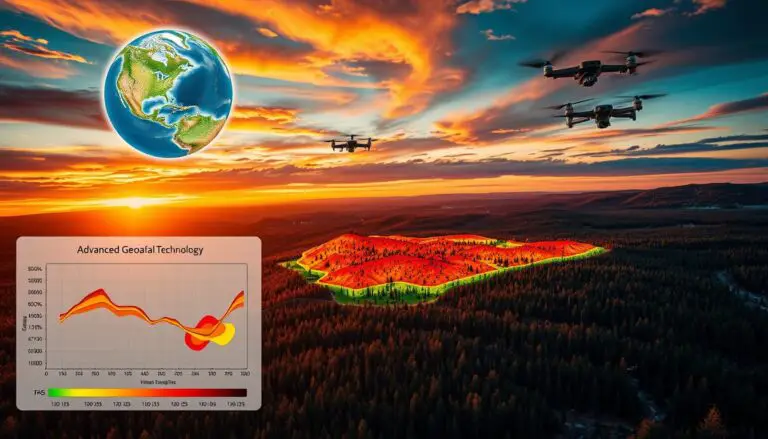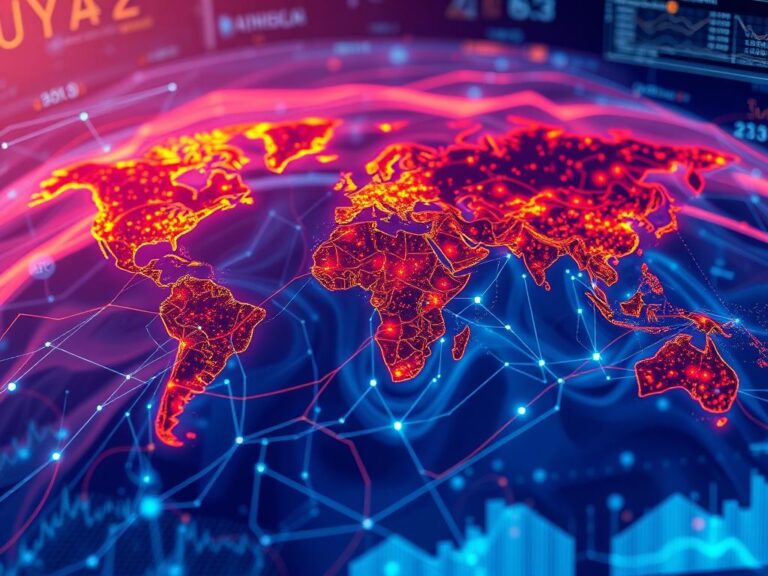GIS in Water Resource Management
Geographic Information Systems (GIS) have become key in managing water resources. They help use water efficiently and sustainably. With water scarcity growing, GIS is vital for solving these problems.
GIS helps collect, analyze, and manage water-related data. It lets decision-makers make better choices about water use. By combining data from various sources, GIS offers a complete view of water systems and their effects.
Key Takeaways
- GIS is a powerful tool for water resource management, enabling efficient and sustainable practices.
- GIS integrates diverse data sources to provide a comprehensive understanding of water systems and their interactions.
- GIS-based decision-making can lead to improved water distribution, conservation, and environmental protection.
- GIS technology is crucial in addressing growing water scarcity and increasing demands on water supplies.
- The application of GIS in water resource management is essential for long-term sustainability and environmental conservation.
Introduction to GIS in Water Resource Management
Geographic Information Systems (GIS) have changed the game in water resource management. They offer tools for analyzing data, integrating information, and making decisions. We’ll look at what GIS is, why water management matters, and how it’s used in the water industry.
Definition of GIS
GIS is a computer system that handles geographic data. It combines different types of data to model real-world situations. In water management, GIS helps professionals tackle water challenges better.
Importance of Water Resource Management
Good water management is key for using water wisely. Water is vital for people, farming, industry, and nature. GIS is essential in managing water by analyzing data and making plans.
Overview of Applications
GIS is used in many ways in water management, including:
- Watershed mapping and analysis
- Hydrological modeling and forecasting
- Groundwater monitoring and management
- Water quality assessment and monitoring
- Water distribution network optimization
- Flood risk mapping and disaster management
- Irrigation and agricultural water management
These GIS uses help water experts make better decisions and solve water problems.
“GIS is a powerful tool that helps us make sense of the complex interactions between water, land, and human activities. It’s a game-changer in the world of water resource management.”
– [Expert Name], Water Resource Specialist
The Role of GIS in Enhancing Water Management
Geographic Information Systems (GIS) are key in water management. They help analyze water quality and track its distribution. GIS uses spatial data to help professionals make better decisions about water.
Analyzing Water Quality
GIS helps agencies like the Environmental Protection Agency (EPA) and the United States Geological Survey (USGS) check water health. It combines water samples, satellite images, and other data to make detailed water quality analysis maps. These maps show problem areas, track pollutants, and guide cleanup efforts.
Tracking Water Distribution
Good water distribution is essential for clean water access. GIS is vital in tracking water through infrastructure networks. It uses data from sensors and flow meters to find leaks, improve water flow, and spot high demand areas. This helps maintain water systems and ensure fair distribution.
GIS has changed how we manage water resources. It gives insights and boosts water system efficiency and sustainability.
Data Collection Techniques in GIS
Effective water resource management needs a lot of data. In Geographic Information Systems (GIS), there are special ways to get and use this data. Remote sensing and field surveys are key methods for water experts.
Remote Sensing
Remote sensing uses satellites and LiDAR to see water resources from above. It helps track water quality and find groundwater. This data is then used in GIS for better analysis and decisions.
Field Surveys
Field surveys give a close look at water resources. Water experts collect detailed data on the ground. This data, combined with remote sensing, gives a full picture of water systems.
Integration of Different Data Sources
GIS’s strength is mixing data from various sources. By combining remote sensing, field surveys, and other data, managers get a complete view. This helps in making better models and decisions for water management.
| Data Collection Technique | Key Benefits |
|---|---|
| Remote Sensing |
|
| Field Surveys |
|
| Data Integration |
|
By using GIS and combining different data, water managers understand their systems better. This leads to smarter and more effective decisions.
GIS Tools and Software for Water Resource Management
Geographic Information Systems (GIS) are key tools in water resource management. They help professionals solve complex problems. GIS software is crucial for analyzing water quality and tracking distribution networks.
Popular GIS Software Used in the Field
ArcGIS and QGIS are top GIS software choices for water management. ArcGIS, by Esri, offers a wide range of tools for data analysis and management. QGIS, an open-source option, is known for its flexibility and cost-effectiveness.
Open-Source vs. Proprietary Tools
- Open-source GIS software like QGIS is budget-friendly, making it great for organizations with limited funds.
- Proprietary tools like ArcGIS offer advanced features and support but are pricier and require ongoing costs.
- The choice between open-source and proprietary water resource tools depends on the organization’s needs, budget, and technical skills.
GIS technology is essential for water resource managers. It helps them make informed decisions and improve their operations.
Case Studies in GIS Water Resource Management
In urban water management, GIS is a key tool. It helps cities use resources better and tackle big challenges. For example, San Diego used GIS to find leaks in its water system. This saved a lot of water and money.
GIS also helps rural areas. In Rajasthan, India, it mapped groundwater. This helped target water projects better. Now, more villages have clean drinking water.
Success Stories in Urban Areas
Los Angeles, facing water scarcity, used GIS to improve water use. It combined GIS with sensor data. This found where water was being used too much. As a result, water use dropped by over 20%.
Rural Water Resource Management
- In Malawi, GIS helped map water points. It found areas without water and helped build new sources.
- In rural Australia, GIS tracked groundwater and rain. This helped plan water use for farming and animals.
| Location | GIS Application | Key Outcomes |
|---|---|---|
| San Diego, USA | Leak detection in water distribution network | Significant water and cost savings |
| Rajasthan, India | Groundwater resource mapping | Improved access to clean drinking water in rural areas |
| Los Angeles, USA | Integrating GIS with real-time sensor data for water conservation | 20% reduction in water usage |
| Malawi, Africa | Mapping distribution of water points | Identification of underserved communities and construction of new water infrastructure |
| Australia | Monitoring groundwater levels and rainfall patterns | Sustainable agriculture and livestock practices |
These examples show GIS’s power in solving water problems. It’s key for managing water in cities and rural areas. GIS ensures everyone has access to water.
Challenges of Implementing GIS in Water Resource Management
Using geographic information systems (GIS) in water management has its challenges. Two big hurdles are making sure data is accurate and finding the right technical skills. These are key to using GIS well.
Data Accuracy and Reliability
Good data is essential for GIS success. But, water data is complex and comes from many places. It’s important to keep this data accurate to make smart decisions.
To solve this, you need strong data management and quality checks. You also need to understand the limits of water data.
Technical Expertise Requirements
GIS needs special skills for water management. People need to know GIS tools and also about water systems and data. This mix of skills can be hard to find.
To tackle this, training and team diversity are key. Working with GIS experts and schools helps keep skills up to date.
| Challenge | Description | Potential Solutions |
|---|---|---|
| Data Accuracy and Reliability | Ensuring the integrity and consistency of diverse water resource data from multiple sources |
|
| Technical Expertise Requirements | Bridging the knowledge gap between GIS software/tools and domain-specific water resource management |
|
Beating GIS challenges in water management needs a complete plan. Focus on data quality, skill building, and teamwork. This way, GIS can help make better decisions and improve water management.
Future Trends in GIS for Water Management
The need for sustainable water management is growing fast. GIS technology is set to play a key role in this. Experts predict exciting changes that will change how we manage water.
Advances in Technology
One big change is the mix of artificial intelligence (AI) and machine learning with GIS. This will help water managers find new insights and make better choices. Also, new remote sensing tech like satellite images and drones will give us detailed data on water and the environment.
Climate Change Adaptation
GIS will be crucial in dealing with climate change’s effects. It will help water managers understand and prepare for these changes. They can use GIS to see how climate change affects water, find weak spots, and plan to fix them.
| GIS Technology Trends | Climate Change Adaptation | Water Management Future |
|---|---|---|
| AI and machine learning integration | Modeling climate change impacts | Optimized resource allocation |
| Advanced remote sensing data | Mapping vulnerable areas | Informed decision-making |
| Predictive analytics and modeling | Developing resilience strategies | Sustainable water management |
The future of GIS in water management looks very promising. New tech and strategies for climate change will make GIS a key tool for keeping our water safe for the future.
Policy and Governance in Water Resource Management
Effective water management needs advanced GIS tech and good policies. Government rules and working with stakeholders are key. They help make and carry out successful GIS water plans.
Role of Government Regulations
Governments make laws and rules for water use and protection. These policies give GIS water management a legal base. They ensure water is used well and everyone gets a fair share.
By setting data standards, government rules help GIS fit into water management smoothly.
Stakeholder Engagement
Good water policy needs everyone involved, like local people, businesses, farmers, and green groups. GIS water management needs input from all to meet everyone’s needs. This makes decision-making fair and open.

GIS tech and strong policies are vital for water management. By matching government rules with stakeholder views, water managers can create better policies. These policies ensure fair water use, sustainability, and protect the environment.
Educational and Training Resources for GIS Professionals
GIS professionals looking to improve in water resource management have many resources. These include formal certifications, online courses, and learning platforms. They help enhance skills and knowledge.
Certification Programs
The GIS Certification Institute (GISCI) offers respected certifications. These show a GIS practitioner’s skills and knowledge. They prove a professional’s ability to use GIS for water management challenges.
Online Courses and Resources
Online courses and materials also support water management with GIS. Platforms like Coursera and Esri offer self-paced programs. They cover topics like remote sensing and hydrological analysis. These resources help GIS professionals grow and stay updated.







